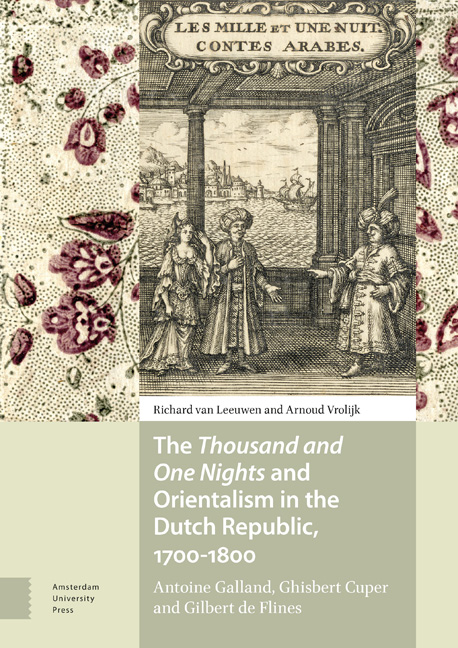 Thousand and One Nights and Orientalism in the Dutch Republic, 1700–1800
Thousand and One Nights and Orientalism in the Dutch Republic, 1700–1800 Book contents
- Frontmatter
- Contents
- Introduction
- 1 The Thousand and one nights and literary Orientalism in Europe
- 2 Dutch Orientalism before 1700
- 3 Antoine Galland and Ghisbert Cuper
- 4 The early editions of the Nights
- 5 Gilbert de Flines
- 6 Later editions in the eighteenth century
- 7 Dutch Orientalism in the eighteenth century
- Conclusion
- Appendix 1 Bibliographic survey of Dutch editions, 1705-1807
- Appendix 2 The David Coster engravings
- Appendix 3 Text samples of the Dutch Nights
- Appendix 4 French and Dutch quotations
- Illustration credits
- Bibliography
- Index
Appendix 2 - The David Coster engravings
Published online by Cambridge University Press: 21 November 2020
- Frontmatter
- Contents
- Introduction
- 1 The Thousand and one nights and literary Orientalism in Europe
- 2 Dutch Orientalism before 1700
- 3 Antoine Galland and Ghisbert Cuper
- 4 The early editions of the Nights
- 5 Gilbert de Flines
- 6 Later editions in the eighteenth century
- 7 Dutch Orientalism in the eighteenth century
- Conclusion
- Appendix 1 Bibliographic survey of Dutch editions, 1705-1807
- Appendix 2 The David Coster engravings
- Appendix 3 Text samples of the Dutch Nights
- Appendix 4 French and Dutch quotations
- Illustration credits
- Bibliography
- Index
Summary
All Husson and Wetstein editions, appearing in The Hague or Leiden between 1705 and 1768, contain engraved frontispiece illustrations by David Coster (c.1680-1752), measuring c.11.5 x 6.5 cm. In all, six different engravings are known to exist:
¶ 1. Parts 1-4 of the composite Leiden copy MRIJKE 1566 contain the almost iconic representation of the frame story: Sultan Shahriyar sits upright in his canopied state bed (right). He is resting his head in his hand and his eyes look pensively into the distance, distracted as he is by the story told to him by Shahrazad, who sits next to him in bed en déshabille. To the left, half-hidden behind the bedcurtains, is her younger sister Dinarzad. In the background is a vaulted niche. The style of the architecture and decoration is late Baroque rather than Oriental; in fact, the emigré French architect and interior designer Daniel Marot might have created such a bedchamber for the lever and coucher of the king-stadtholder William III at Het Loo or Hampton Court. The colonnaded parapet is similar to the one in King Louis XIV's state bedchamber at Versailles. The only Oriental detail is the turban worn by the sultan.
¶ 2. From the fourth Husson edition onwards (1707-1719), parts 1-2 show a new and far more elaborate frontispiece, with a reduced-size image of the earlier bedchamber scene as depicted in parts 1-4 of the third edition, surrounded by five little pictures. All images are set in an architectural composition known in book design as an aediculum, ‘little building’, crowned by a curved Classical pediment with the title Les Mille et Une Nuit. Top left: the story of the Porter and the Ladies of Baghdad (part 1, p. 231 – part 2, p. 14); top right: the Third Calender and the Flying Horse (part 2, pp. 161-247); below left: the Fisherman and the Jinni (part 1, pp. 113-230); below right: the story of the Greek King Younan and his Doctor Douban (part 1, pp. 131-164). At the bottom is a second illustration from the same story showing the moment of the doctor’s execution. It is this multi-image engraving that was to be adopted time and again in the Dutch retranslations.
- Type
- Chapter
- Information
- Thousand and One Nights and Orientalism in the Dutch Republic, 1700–1800Antoine Galland, Ghisbert Cuper and Gilbert de Flines, pp. 141 - 146Publisher: Amsterdam University PressPrint publication year: 2019


